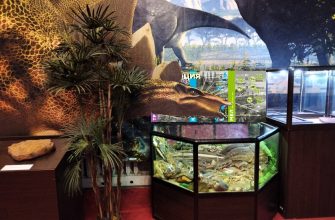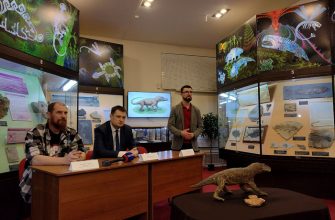A.U.Khlyupin
The Geological Structure of the District.
Reconstruction of Conditions of Sediments Accumulation.
The Geological Structure of the District.
The sediments, burial places of large para – reptiles and beast like reptiles, belong to Upper part of Tatarian Stage – the latest subdivision of sediments of Permian System of Russian Platform. According to a generally accepted geological scale the age of these sediments is 250 million years old. Geological structure of the sediments was studied in the precipices of the right bank of the Vyatka river below Kotelnich. They look like in the following way:
1). At the bottom of the section there is a layer of crossing fine and thick alevrites (parts of 0.05 – 0.005mm) and marls (of carbonate and clay rocks). It is called Vanyushonkovskaya Member. As a rule, interlayers of thick алевриты are connected with the finds of Pareiasaurs. There were marked out only 4 such horizons. Interlayers of fine alevrites usually have no fossils. The sediments of the Vanyushonkovskay Member belong to the rests of flood planes, for which shallow basins of weak salty with low hydrodynamic activity are typical. The thickness of the Member can reach 10 meters. The bottom of it is hidden under the Vyatka river.
2). Borovikovskaya Member consists of middle – smallgrainy quartz – полевошпатовый sand. Because of heamatetical alturation sand has grey – orange colour. The Member is stretching like a sloping lens from the 7 to 19 km. to the South from the port of Kotelnich and its thickness is about 17 m. The lower line of the Member is situated on the Vanyushonki depositions. Evident indications of interruption of sediment accumulations in the bottom of the thickness are not found. Typical structure and texture features of thickness (such as crossbeds of 0.5 to 3 m. of thickness, fine grading and окатанность of grains of sand, character of grains and granule structure) point on its eolian origin. So, it can be affirmed, that Borovikovskaya lens is a peninsular eolian formation, presented by ancient river-side desert dunes and sand-hills. An interesting peculiarity of Borovikov lens is its control of spreading of fossil tetrapod remains in the lower, more ancient deposits. It seems a breach of causal and effect relationship. To explain it is possible with reconstruction of the way of sediments accumulation by facial lithological analysis, which is written about in the following chapter.
3). Chizev Member is presented by the small lenses of channel grey – coloured mixed grained sandstone, containing a variety of plants and separate remains of fish bones. These deposites were made by little springs which cut the bank eolian formations.
4). By its lithological structure Shestakov Member is analogous to Vanyushonkovskaya Member, but in contrast to it fossil remains of pareiasaur are not found in it still now. A remarkable feature is that there is a sand lens in the upper part of the thickness in the north part of the studied area. It contains numerous remains of dicynodonts – plant-eating four-legs fossils (more then 70 finds in the bed of 2 meters thickness and 350 meters length. Beyond the borders of Borovikov Lens the Shestakov Member hasn’t got a good border to lower Vanyushonkov sediments. So, it’s possible to suppose that from the beginning of the formation of Vanyushonkov thickness and up to the end of Shestakov one there was only one common shallow sea basin. On the surrounded land there was a desert climate. A cost line of the basin migrated periodically. The thickness of Shestakov Member is about 20 m.
5). Sokolovogorskaya Member belongs to Vyatka horizon and it is a principle new foundation. It is presented by lens of grey many-coloured sometimes much ferritic sands with gravel – pebble conglomerate of under laying rocks and separate bone remains in the bottom of the thickness. The thickness of the Member is about 15 m. These sands are alluvial (river) river beds foundations. The orientation of crossbeds proves that in that period a main process of carrying over of fragment material was from the East to the West.
Reconstruction of Conditions of Sediments Accumulation.
Revealed peculiarities of deposits geological structure let us restore a geological history of the area in Upper Permian age. All stages reconstruction of conditions of sediments accumulation is shown on the three – dimensional block – diagrams (picture 2 A – D ). For better clearness these diagrams are given without a real scale. A front vertical wall of the block (line A – B) is conform to a modern bank precipice of the Vyatka river within 20 km. down stream from Kotelnich to Vishkil.
During the first stage within the section line of the modern bank deposited shallow sea sediments of a warm, weak – salt and rather calm sea basin (picture 2 A). The bank line was very near to the west from this section and periodically migrated to different directions. It is proved by a periodically change of large and little алевриты in the sediments section, as far as the size of sediments changes according to a distance from a bank line and basin depth. The period of a bank line digression to the West conforms to horizons of accumulation of deeper thin carbon алевритового silt. The periodical movement of a bank line to the East is marked by rough алеврит in deposits section. There were more shallow sediments, most likely they formed silt drainage, which was uncovered on the surface of the seashore time to time (during ebbs). Most of the researchers are sure that quite large and clumsy pareiasaurs walking along a seashore got in liquid jelly silt mass and were buried by following sediments. 300 buried pareiasaurs were found on the bank lower the lens of Borovikov sandstone. On the present period of investigations it is impossible to determine an exact speed of sediments accumulation. But according to a fine preservation of a high situated part of skeletons (a skull) it is possible to affirm that it was very fast.
During the movement of a sea line to the West burials were far away from the modern bank of the Vyatka river and nowadays it is impossible to find them.
The following regression of the sea to the East brought to the fact that within 7 – 19 km. to the South from Kotelnich one of the prominences of the bank crossed with a modern river precipice. Just it we can see as a sand lens of Borovikov Member (picture 2 B). Springs cut in this peninsula put down separated parts of fish skeletons and plants organic remains brought from the land (Chizhev Member).
The following tansgression of the sea moved a sea line to the West again and carbon алевритовые silts of a shallow sea of Shestakov Member were deposited in the area of a modern bank of the Vyatka river (picture 2B). Only on the North of the area in upper levels of the Member there is a lens with plenty of fossil remains of dicynodonts. It is possible that this burial is connected with an undercurrent gutter where the stream flew.
At the end of Shestakov Time it was a full regression of the sea. Being in subaerial condition the plain was cut by some water – streams, mainly flowing from the East to the West. It is possible the influence on their direction was made by the raising Urals Mountains and regression of sea water from the Russian Platform. Ravine – like valleys were made by those water streams. They were filled by quartz полевошпатовыми differ grain sands with gravel – pebble conglomerates of вмещающих marls, алевролиты, and bones’ fragments in the bottom (picture 2 D).
Since the end of the Permian Age the territory of Vyatka region has no considerable tectonic vibrations. There were conditions of hilly continental plain with local and very moderate manifestations of erosion and sediments accumulation on it.
PROBLEMS OF PALAEOGEOGRAFICAL RECONSTRUCTION
The given region is studied quite in details. In spite of it there are a lot of unsolved problems in the question of palaeogeografical reconstructions. Mass death of reptiles on the limited area is very unexplained. The upper given explanation can be only a working hypothesis but not an absolutely proved scientific fact. A fast speed of sediments’ accumulation (a fine preservation of fossils proves it) doesn’t conform to little thickness of beds and quite long age interval of the whole deposits thickness.
The question about food is unclear still now. Pareiasaurs couldn’t walk for a long distance looking for food. But inside deposits there are no evidences about considerable amount of plant material. The quantity of organic that is met in thin lenses of Chizhev Member is not enough for such numerous herd of pareiasaurs. Moreover this organic is carried by slow water streams.
The deposits of the Vyatka Suite (Sokolovogora Member) finish a succession of sediments’ cover of this region, not counting modern rivers’ and sea – swamp’ deposits. The thickness of this member of sands, deposited by small water streams, could not be thicker than 30-40 m. So, a size of erosion section can be 15-25 m. max. Taking into account the middle size of surface erosion 0.1 mm in a year we get the age of Sokolovogora Member. It is about 250 000 years old that is in a hundred times younger than generally accepted age of Upper – Permian deposits – 250 mln. years old.
According to aforesaid facts it is possible to make a following conclusion: nowadays the problem of palaeogeografical reconstruction of the conditions, which were on the Vyatka Region territory in Late Permian Time can’t be closed. The decision of this question depends on the next researches. But however, just now it is possible to affirm that the exploration of the Kotelnich Locality of Pareiasaur let make clear on such basic scientific questions as the geological history of our Earth and the evolution of organic world.






